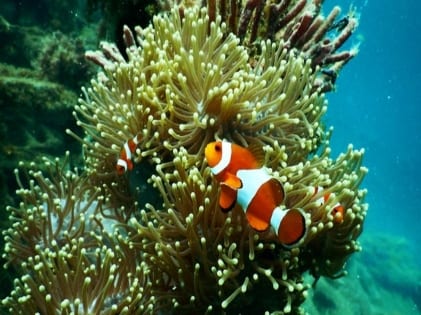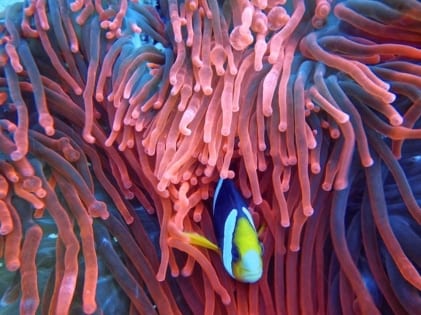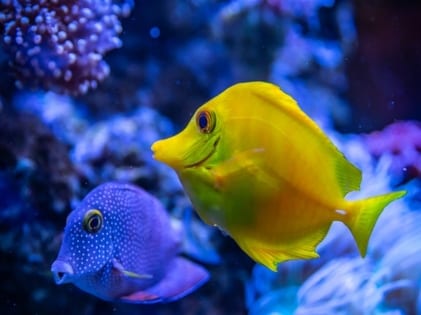 Coral reefs are currently in great distress due to the warming oceans bleaching the corals and eventually making them die. Conservationists are extremely worried about saving them.
Coral reefs are currently in great distress due to the warming oceans bleaching the corals and eventually making them die. Conservationists are extremely worried about saving them.
But there’s something new on the horizon that can be good news for the conservationists. Coral reefs are beautiful, and their stunning visuals, complete with their purple plumes of sea sponges, can mesmerize anyone who visits them. But there is more to reefs than their spectacular visual displays. They are also the noisiest. And the Crustaceans can make amazing noises creating a dazzling cacophony.
A Scientific Discovery suggests that live reef sounds attract larval reef fish. Reef noise can catch more larvae than with degraded reefs with no noise. These reefs attract larvae of more species with varied families. Some scientists have played underwater sounds in the degraded portions of the Great Barrier Reef in Australia. These sounds will mimic those of healthy reefs and attract shoals of varied species of fish.
The pitch and the loudness of invertebrates
 Invertebrates mostly cause high-frequency sounds. Here the snapping shrimps take the cake in terms of pitch and loudness. Snapping shrimps use their enlarged claw that, makes a loud snap when it closes rapidly.
Invertebrates mostly cause high-frequency sounds. Here the snapping shrimps take the cake in terms of pitch and loudness. Snapping shrimps use their enlarged claw that, makes a loud snap when it closes rapidly.
If you are near the tiny crustacean, the sound can reach the level of 190 decibels. The sound is comparable to any jet plane taking off. The only saving grace is that, you won’t have to deal with the loud noises as the shrimps live deeply embedded in coral crevices. And they snap away day in and night. Reef fish larvae can help them see, hear, and smell reef habitat, and it helps the fish swim towards it.
The underwater soundscape is required for the fish larva to know whether a coral reef is nearby and whether it is the best place to settle in. But some species have better hearing than others, and the depth and structure of the habitat can impact the way sounds come out from the reef.
The degradation of reefs
Most young fish are attracted to the reefs after they hatch and spend the open ocean’s larval stage. But as soon as the reef starts getting degraded, the juvenile fish prefer to move elsewhere, and the reef starts degrading even more. The scientists conducted their experiments at the northern Great Barrier Reef area called the Lizard Island Research Center. Before conducting the study in 2017, this area started experiencing severe mass bleaching events, with 60% of live coral becoming bleached.
The experiment on the bleached reefs

Experimental treatments on the reefs have some interesting findings. They started with a dummy loudspeaker (to send visual cues that may impact fish behaviors), known as a real loudspeaker or acoustic enrichment treatment playing the reef sounds. The playback started for 40 days straight, mostly are nighttime, which is when fish settlement occurs.
After experimentation, the researchers concluded that the acoustically-enriched reefs attract more juvenile damselfishes than the reefs that were non-enriched. It helped increase the Biodiversity to more than 50%, and it was not just damselfishes who got attracted to the sound, but there were other fish species.
More about reef restoration
 The fish can restore a coral reef to good health. They clean the reef and create more space for corals to regrow. Acoustic enrichment helps create a ripple effect. And this helps the other fishes join the communities established earlier, helping the settlement to grow more.
The fish can restore a coral reef to good health. They clean the reef and create more space for corals to regrow. Acoustic enrichment helps create a ripple effect. And this helps the other fishes join the communities established earlier, helping the settlement to grow more.
This suggests that acoustic enrichment is a new and potentially powerful tool to help fish communities’ grow on unhealthy coral reefs. The authors and scientists basing on the findings, warned that only creating acoustic music cannot be the only way to attract fishes and resurrect the degraded reefs.
One needs more scientific interventions and a more balanced approach to address the causes of coral reef decline and climate change. Without these steps, the fishes who got attracted to the reefs will finally leave the habitat. And when they find out that there is little to offer in food and shelter, this seems like the logical thing for them to do. However, recent studies show that with music, it is possible to restore these ruins. And that’s a step in the right direction towards protecting nature and conserving the environment!




